16.7: Effects of Multilingualism on Development
- Last updated
- Save as PDF
- Page ID
- 173876
- Todd LaMarr
\( \newcommand{\vecs}[1]{\overset { \scriptstyle \rightharpoonup} {\mathbf{#1}} } \)
\( \newcommand{\vecd}[1]{\overset{-\!-\!\rightharpoonup}{\vphantom{a}\smash {#1}}} \)
\( \newcommand{\id}{\mathrm{id}}\) \( \newcommand{\Span}{\mathrm{span}}\)
( \newcommand{\kernel}{\mathrm{null}\,}\) \( \newcommand{\range}{\mathrm{range}\,}\)
\( \newcommand{\RealPart}{\mathrm{Re}}\) \( \newcommand{\ImaginaryPart}{\mathrm{Im}}\)
\( \newcommand{\Argument}{\mathrm{Arg}}\) \( \newcommand{\norm}[1]{\| #1 \|}\)
\( \newcommand{\inner}[2]{\langle #1, #2 \rangle}\)
\( \newcommand{\Span}{\mathrm{span}}\)
\( \newcommand{\id}{\mathrm{id}}\)
\( \newcommand{\Span}{\mathrm{span}}\)
\( \newcommand{\kernel}{\mathrm{null}\,}\)
\( \newcommand{\range}{\mathrm{range}\,}\)
\( \newcommand{\RealPart}{\mathrm{Re}}\)
\( \newcommand{\ImaginaryPart}{\mathrm{Im}}\)
\( \newcommand{\Argument}{\mathrm{Arg}}\)
\( \newcommand{\norm}[1]{\| #1 \|}\)
\( \newcommand{\inner}[2]{\langle #1, #2 \rangle}\)
\( \newcommand{\Span}{\mathrm{span}}\) \( \newcommand{\AA}{\unicode[.8,0]{x212B}}\)
\( \newcommand{\vectorA}[1]{\vec{#1}} % arrow\)
\( \newcommand{\vectorAt}[1]{\vec{\text{#1}}} % arrow\)
\( \newcommand{\vectorB}[1]{\overset { \scriptstyle \rightharpoonup} {\mathbf{#1}} } \)
\( \newcommand{\vectorC}[1]{\textbf{#1}} \)
\( \newcommand{\vectorD}[1]{\overrightarrow{#1}} \)
\( \newcommand{\vectorDt}[1]{\overrightarrow{\text{#1}}} \)
\( \newcommand{\vectE}[1]{\overset{-\!-\!\rightharpoonup}{\vphantom{a}\smash{\mathbf {#1}}}} \)
\( \newcommand{\vecs}[1]{\overset { \scriptstyle \rightharpoonup} {\mathbf{#1}} } \)
\( \newcommand{\vecd}[1]{\overset{-\!-\!\rightharpoonup}{\vphantom{a}\smash {#1}}} \)
Multilingual children grow to know and use multiple languages, and their development is not akin to “two monolinguals in one person” (Grosjean, 1989). One reason is that children’s experience is divided between their different languages. Moreover, multilingual children must engage in a constant “mental juggling” of their two languages (Kroll et al., 2011; Kroll & Bialystok, 2013; Bosworth, Binder, Tyler & Morford, 2021), which can present challenges and opportunities for cognition, language representation, and processing (Marian & Shook, 2012). The experience of being multilingual can have an impact on both brain and cognitive development. [1]
Brain Development
Research with multilingual infants indicates that the human brain is adept at acquiring multiple languages simultaneously (Ferjan Ramírez et al., 2016; Garcia-Sierra, Ramírez-Esparza, & Kuhl, 2016), and that infants who grow up multilingual, efficiently monitor and control their languages (Byers-Heinlein, Morin-Lessard, & Lew-Williams, 2017). Studies also show that acquiring multiple languages in infancy, compared to acquiring an additional language in later childhood or adolescence, results in more efficient neural language processing (Berken, Gracco & Klein, 2017; Klein, Mok, Chen & Watkins, 2014) and higher brain tissue density in regions supporting language, memory, and attention (Mechelli et al., 2004). [2]
Multilingualism sculpts the brain’s functional and structural organization (Arredondo, Aslin & Werker, 2021; Hayakawa & Marian, 2019; Pliatsikas, 2020). For example, multilingual infants show different brain responses to native and non-native speech sounds compared to monolingual infants (Conboy & Kuhl, 2011; Garcia-Sierra et al., 2011), and multilingual children recruit different brain areas during sentence processing (Jasinska & Petitto, 2013). Adult research shows that the age of acquisition of a second language affects the brain’s language networks (Berken, Gracco, & Klein, 2017), and functional connectivity (Kousaie, Chai, Sander, & Klein, 2017). Moreover, multilingualism also affects the structure of both gray (Andrea et al., 2004; Ressel et al., 2012) and white matter (Kuhl et al., 2016) in adults. Looking at the tissue in the brain, there are regions that predominantly contain neuron cell bodies and dendrites and regions that are largely composed of just axons. These two regions are often referred to as gray matter (the regions with many cell bodies and dendrites) or white matter (the regions with many myelinated axons). Patterns of structural differences appear to depend on whether the languages were acquired simultaneously from birth, or sequentially before age five (Berken, Gracco, Chen & Klein, 2015), suggesting that timing of multilingualism interacts with brain development. [1] [3]
Garcia et al., (2018) analyzed the brain activity of 4.5 month old monolingual and multilingual infants in their native language and two foreign languages. Figure \(\PageIndex{1}\) shows the event related potential (ERP) waveforms of monolingual (left side) and multilingual (right side) infants to native (blue), Italian (green) and German (red) languages. The ERP component they looked at was the P200. Most ERP components are referred to by a letter (usually N or P) indicating polarity (negative/positive), followed by a number indicating the latency or timing delay between the presentation of a stimulus and the specific brain response in milliseconds. So the P200 component refers to a positive spike around 200 milliseconds after the stimulus. [4]
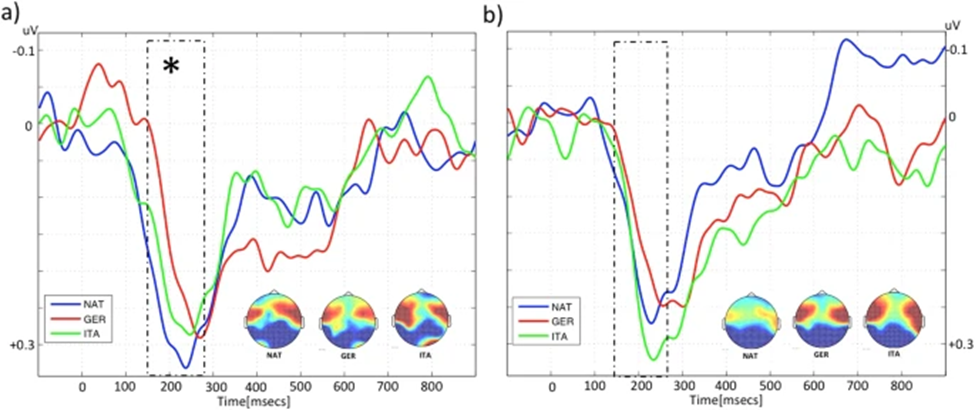
Although both groups of infants showed a P200 response to all languages, monolinguals showed shorter latencies (less processing time) of the P200 component for their native language compared to the language of the different rhythmic class (German). In other words, the P200 waveform for monolinguals listening to their native language occurred earlier than their responses for the non-native languages, especially German. This can be seen in Figure \(\PageIndex{1}\) by the early peaking of the waveform for their native language. In contrast, multilinguals did not show a statistically significant difference in the latency of the P200 component for any of the languages. This lack of differences may reflect multilinguals’ reduced familiarity with each of their languages since multilinguals’ speech input is split across multiple languages. Therefore, multilinguals’ P200 response to their native language would be more similar to the one elicited by the unfamiliar languages for monolinguals. The results point in the direction of different language discrimination strategies for multilingual and monolingual infants. While only monolingual infants show early discrimination of their native language based on familiarity, multilinguals perform a later processing pattern which is compatible with an increase in attention to the speech signal. This is the earliest evidence found for unique brain specialization induced by multilingualism. [6]
Neuroimaging studies suggest that monolingual infants activate a left-lateralized brain network in response to spoken language, which is similar to the network involved in processing spoken and signed language in adulthood. Left-lateralization to language refers to the brain processing language primarily on the left side. How does language experience, like being multilingual, impact this left-lateralization process? To answer this question, researchers conducted a functional near-infrared spectroscopy (fNIRS) experiment with sixty infants between the ages of 4 to 8 months (Mercure et al., 2020), some infants were spoken language monolinguals and some were spoken language multilinguals, but neither of these two groups had ever been exposed to sign language. [7]
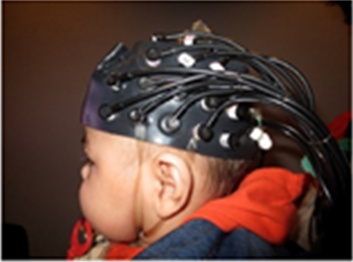
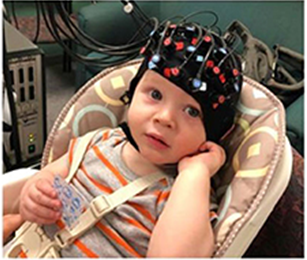
Functional near-infrared spectroscopy (fNIRS) measures hemodynamic (blood flow) responses elicited from neuronal activation by shining near-infrared light into the brain. Figure \(\PageIndex{2}\) shows an infant and a toddler wearing the fNIRS cap during an experiment. As this light passes through the head, some of it is absorbed by the blood flowing through the brain. When brains are active, they require oxygen from the bloodstream一the harder a particular area of the brain is working, the more oxygenated blood will be sent to that area and the more light will be absorbed there. Because the fNIRS cap measures how much light comes back out of the brain, the areas with less light shining through them are the most active. [7] [9]
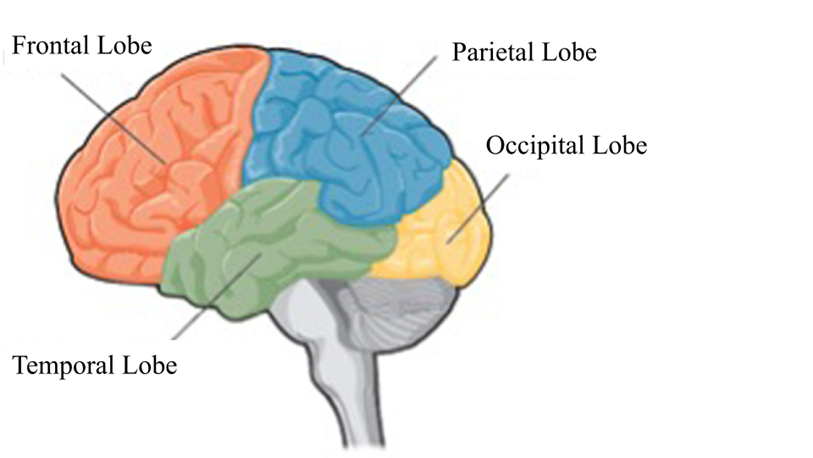
As shown in Figure \(\PageIndex{4}\), across all infants, viewing sign language elicited a significant increase in oxygenated blood mainly in the right temporoparietal area when all infants were considered together as a single group. In monolinguals, sign language elicited an increase in oxygenated blood in the temporoparietal area of both hemispheres. In multilinguals, a significant increase of oxygenated blood was observed in the right temporoparietal area. Results indicate that the neural tissue supporting language is plastic in infancy and influenced by language input and language modality (spoken modality versus signed modality), suggesting that there may be different neural paths to language development based on different language experiences. [17]
As shown in Figure \(\PageIndex{4}\), across all infants, viewing sign language elicited a significant increase in oxygenated blood mainly in the right temporoparietal area when all infants were considered together as a single group. In monolinguals, sign language elicited an increase in oxygenated blood in the temporoparietal area of both hemispheres. In multilinguals, a significant increase of oxygenated blood was observed in the right temporoparietal area. Results indicate that the neural tissue supporting language is plastic in infancy and influenced by language input and language modality (spoken modality versus signed modality), suggesting that there may be different neural paths to language development based on different language experiences. [7]
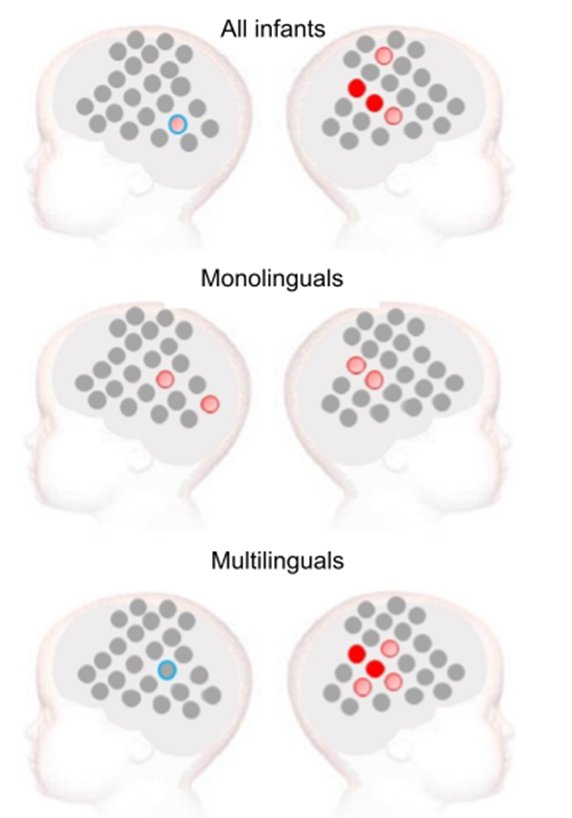
Although research on the brain development of infant and toddler multilingualism is a growing area with more questions than answers, the research so far seems to suggest that, like what behavior research has discovered, the development of multilinguals is somewhat unique and different from that of monolinguals.
Cognitive Development
Does being multilingual lead to enhanced cognitive abilities? Many claim that the experience of multilingualism leads to a cognitive advantage in executive functioning, a view that has gained substantial traction within the popular media. According to the prevailing multilingual advantage hypothesis, because the mental representations for each language are always “turned on”, multilinguals become highly practiced at selecting and controlling attention after years of experience managing conflicts between competing phonological and lexical mental representations. Over the course of time, these practice effects generalize to problems outside the domain of language and contribute to a bilingual advantage in executive functioning (Bialystok, 2011, 2017; Bialystok, Craik & Luk, 2012; Kroll & Bialystok, 2013). Research suggests that potential cognitive advantages to being multilingual appear early, even within the first three years of life. [11]
The idea that each language known by a multiglinal is always “turned on” suggests that even when they are speaking, writing, listening or thinking in one language, mental representations for the other language(s) are simultaneously activated (Kroll, Bobb & Hoshino, 2014). For example, Figure \(\PageIndex{5}\) has three pictures in it: a piece of paper, cheese (wedges and slices) and a wrist watch. In an eye-tracking experiment, researchers showed participants arrays of stimuli containing multiple pictures (Shook & Marian, 2012), similar to this. As participants looked at the pictures, they heard a statement that named one specific picture in the array and all the participants needed to do was look at the picture named. So if a participant was looking at the array of pictures in Figure \(\PageIndex{5}\) and heard “cheese”, all they would need to do was look at the picture of cheese. Quite simple, huh? The results however revealed something interesting.

Some of the participants looked at another picture before looking at the named picture in every trail. To find out why, we need to look closer to the backgrounds of the participants. In this study, participants included hearing English monolinguals and hearing American Sign Language(ASL)/English multilinguals. The pictures were carefully selected to contain pictures with ASL translations that shared phonological features. The ASL signs for cheese and paper are phonologically similar. To illustrate, Figure \(\PageIndex{6}\) shows the ASL signs for ‘cheese’ and ‘paper’. These two signs share the phonological feature of handshape. The findings from the study revealed that the ASL/English multilinguals spent more time looking at signs that were phonologically similar to the named picture (Shook & Marian, 2012). The results suggest that even though the study was conducted in English and did not involve ASL at all, ASL was simultaneously activated when English was activated. This study supports numerous others in finding that the mental representations of each language are always active in multilinguals (Kroll & Bialystok, 2013; Villwock, Wilkinson, Piñar & Morford, 2021).
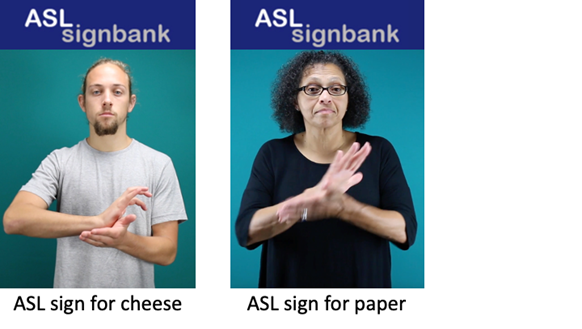
Enhanced cognitive abilities, mainly related to executive function, appear early, even in infancy and toddlerhood (Barac, Bialystok, Castro & Sanchez, 2014). Bilingual toddlers between 24 and 31 months of age show enhanced inhibitory control, another executive function, compared to monolingual toddlers (Crivello et al., 2016). A study even found evidence of enhanced cognitive abilities in infancy! Seven month old infants have greater cognitive control, another executive function, compared to monolingual infants (Kovács & Mehler, 2009). [14]
It is important to note that not all studies have found cognitive advantages related to multilingualism (Giguere, Dickson, Tulloch & Hoff, 2022). A mounting number of large-scale comparisons of multilingual and monolingual adults (Lehtonen et al., 2018; Nichols et al., 2020; Paap et al., 2013, 2015), however, have cast doubt on the multilingual advantage account. Despite many studies claiming to show supportive evidence from sets of multilinguals tested across the lifespan, these multilingual effects are currently the subject of intense research debate. For example, in a study of over 11,000 people, when confounding variables were controlled for, multilinguals did not show any advantage in executive function (Nichols et al., 2020). As with adult studies, large meta-analyses on the overall research with multilingual children have found little support for a cognitive advantage (Gunnerud et al., 2020; Lowe, Cho, Goldsmith & Morton, 2021). [15]
[1] Byers-Heinlein et al., (2019). The case for measuring and reporting bilingualism in developmental research. Collabra: Psychology, 5(1). CC by 4.0
[2] Ramírez & Kuhl (2020). Early second language learning through SparkLing™: Scaling up a language intervention in infant education centers. Mind, Brain, and Education, 14(2), 94-103. CC by 4.0
[3] “Anatomy and Physiology” on OpenStax is licensed under CC by 4.0.
[4] “Event-related potential” from Wikipedia is licensed under CC by SA 3.0
[5] Image from Garcia et al., (2018). Evoked and oscillatory EEG activity differentiates language discrimination in young monolingual and bilingual infants. Scientific Reports, 8(1), 1-9. CC by 4.0
[6] Garcia et al., (2018). Evoked and oscillatory EEG activity differentiates language discrimination in young monolingual and bilingual infants. Scientific Reports, 8(1), 1-9. CC by 4.0
[7] Mercure et al., (2020). Language experience impacts brain activation for spoken and signed language in infancy: Insights from unimodal and bimodal bilinguals. Neurobiology of Language, 1(1), 9-32 CC by 4.0
[8] Images adapted from Mercure et al., (2020). Language experience impacts brain activation for spoken and signed language in infancy: Insights from unimodal and bimodal bilinguals. Neurobiology of Language, 1(1), 9-32 CC by 4.0 and Soltanlou & Artemenko (2020). Using light to understand how the brain works in the classroom. Frontiers in Young Minds, 8, 88. CC by 4.0
[9] Aanestad et al., (2021) What is happening in children’s brains when they are playing pretend? Frontiers in Young Minds, 9, 644083.
[10] Image adapted from “The brain and spinal cord” on OpenStax is licensed under CC by 4.0
[11] Lowe et al., (2021). The bilingual advantage in children’s executive functioning is not related to language status: A meta-analytic review. Psychological Science, 32(7), 1115-1146.
[12] Images adapted from Unsplash.
[13] Images adapted from Hochgesang, Crasborn, & Lillo-Martin (2022). ASL Signbank. New Haven, CT: Haskins Lab, Yale University. CC by NC SA 4.0
[14] Espinosa (2015). Challenges and benefits of early bilingualism in the US context. Global Education Review, 2(1). CC by 3.0 NC
[15] Leivada et al., (2021). On the phantom-like appearance of bilingualism effects on neurocognition: (How) should we proceed? Bilingualism: Language and Cognition, 24(1), 197-210. CC by 4.0

